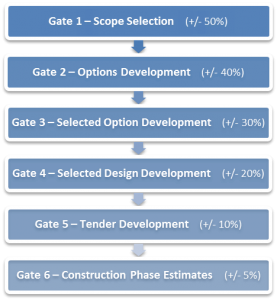
Crossrail Approach to Estimating
Document
type: Micro-report
Author:
Julian Bartlett
Publication
Date: 26/02/2016
-
Abstract
This report summarises Crossrail’s approach to Estimating, to provide predictability around capital investment and operating costs as well as the critical evaluation of affordability and value for money. This report sets out the role of the Programme Controls Estimating Team, the procedures and approach undertaken as well as the benefits and lessons learned, including how estimating played a crucial role in gaining authority to proceed from the Government.
This page outlines how Crossrail established a robust and consistent approach to estimating, and is therefore applicable to anyone aiming to establish a similar approach across a large programme or portfolio of projects.
-
Read the full document
Introduction and Industry Context
On Crossrail, the estimating function were responsible for the initial baseline estimate computation to discrete estimate validation, benchmarking, pre-tender estimating, tender evaluation, value management, compensation event review, global benchmarking and management of critical issues. The central estimating team also provided leadership, guidance, and resource augmentation to the projects to help in managing pre and post contract estimating requirements. This paper should be read in conjunction with Crossrail’s Estimating Procedure.
Roles and Responsibilities
Crossrail utilised a Programme Controls Central Estimating team, to produce and review estimates centrally. The RACI matrix below shows the responsibilities of this central team regarding the twelve distinct estimating activities which were identified.
Process Head of Cost Estimating Team Area Cost Manager Project Cost Engineer Project Manager 1 Estimate Production A C I R I 2 Reforecast A R C C I 3 Pre Tender Estimates A R C C I 4 Pricing Documents A R C C I 5 tender Evaluations A R C C C 6 Compensation Events A C I R C 7 Programme Change Control A R C C I 8 Third Party A R C C I 9 Whole Life Cost Appraisals A R C C I 10 Benchmarking A R C C I 11 Investment Authority Validation A C I R C 12 LAD Calculation Validation A C I R C R = Responsible A = Accountable C = Consulted I = Informed Figure 1: Process roles: RACI matrix
Estimating Governance Levels
Crossrail identified a project gateway process to support its internal approval processes. The Crossrail gateway process was mapped to: the RIBA Plan of Work; Network Rail’s GRIP process; London Underground Assurance; and the OGC Gateway process.
The purpose of this mapping was such that all Estimate Providers were clear of expectations when preparing cost estimates. This project gateway process is outlined on the right, along with minimum confidence levels required for Point Estimates produced at each stage.
Figure 2 – Crossrail Project Gateway Process
Estimate Principles, Content and Supporting Details
An estimate template and Cost Estimating Procedure were produced and stored centrally to facilitate a consistent approach across the Programme. All estimates were required to contain a full breakdown of all quantities measured according to Standard Method of Measurement 7 (SMM7), Civil Engineering Standard Method of Measurement (CESMM 3) and the Network Rail Method of Measurement as appropriate, and rates used in preparing ‘point estimates’.
Lump sum allowances were only permitted where insufficient design information was available to quantify and price the work in detail. The assumptions used in arriving at those sums needed to be clearly stated in the estimate.
Particular attention was drawn to the following cost items which were shown separately in the WBS and were required to be priced separately in the point estimate. It was not acceptable for these items to be incorporated into the unit rates because of the diverse nature of projects (civils, stations and operations) across the programme:
- Direct Works
- Advanced and Enabling Works
- Preliminaries
- Overheads and profit
Estimates were required to reflect the timing, method of construction durations and constraints set by their method and construction and programme, with a base date agreed and noted. The individual cost schedules for direct/contract work were to be inclusive of redundant/excess material, testing & commissioning (where appropriate). Such costs included for protection measures, possessions and normal site risks.
All estimates for ‘on-network’ works were required to clearly state the assured possession strategy on which the costs have been based, including supporting details clearly showing how the possession costs were calculated.
With the exception of a specific list of ‘permitted exclusions’ (e.g. Operating, maintenance and renewal costs, Purchase and disposal of land and property, Project risk or contingency), the estimator was responsible for producing a comprehensive estimate of the works, containing no further exclusions.
Lessons Learned
- Utilisation of a central estimating team to coordinate and assure the production of estimates across 12 multi-disciplinary design consultancies, in order to establish a Total Project Estimate, leading to early sponsor satisfaction (note this topic is further covered in document reference 1F-004)
- Time-phasing of the Total Project Estimate to calculate inflationary allowances
- Creation of a single, robust estimate as a basis for tender evaluation
- The dedicated programme-wide value management exercise was used to optimise the scheme prior to the Treasury’s Comprehensive Spending Review, which lead to a CapEx saving of £1bn, as well as reduced risk in bringing assets into use. This ultimately led to the Government giving the scheme the authority to proceed.
Recommendations for Future Projects
- Establish the initial control baseline as soon as possible during the set-up phase, aligning scope, cost, schedule and risk in order to establish a single source of truth is the primary method of control during the early stages
- Utilise a central estimating team where possible to increase the consistency of estimates, and to provide assurance over estimates produced by others
- Utilise a central estimating team where possible to analyse and estimate the impact of programme-driven change on a consistent bases, as well as to provide estimating support to project teams. This increases the reliability of estimates, and also establishes a single point of accountability.
-
Authors
Julian Bartlett - Crossrail Ltd, Turner & Townsend
Director – Turner & Townsend
Crossrail Head of Cost
Julian Bartlett is a Director at Turner and Townsend and has 18 years’ experience in commercial management on a wide range of major projects. Julian has been at Crossrail since September 2009 as Head of Estimating, and latterly Head of Cost within the Programme Controls function, including acting as the Cost lead for all Crossrail station projects. His role has primarily entailed management of estimate production and the commercial review and challenge of estimates produced by all the industry partners including Network Rail and LUL, as well as leading the management of cost post-contract to ensure value.

